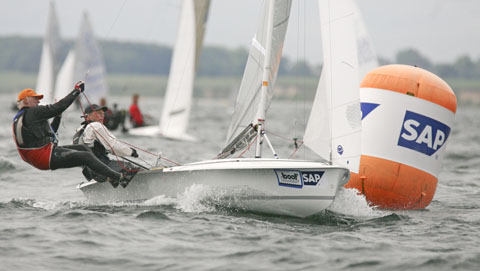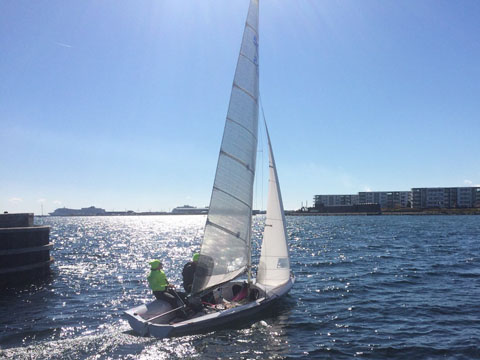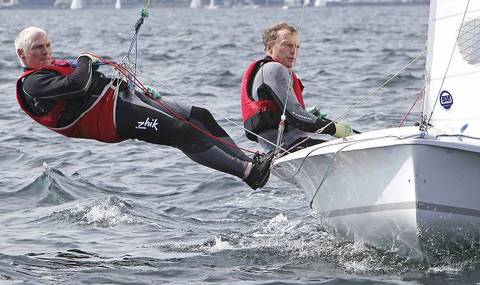505 Worlds 2010 evaluation
by Jorgen and Jacob Bojsen-Møller after the Worlds in Aarhus, Denmark.
Editor’s Note: This article was taken from the www.baadmagasinet.dk as a measure of preserving it for the enjoyment of the 505 Class.
After the end of the very well arranged
World Championship for 505
at Kaløvig, most teams will evaluate their own efforts. Which is
what we also have done.
Overall it went well for us because:
• We won a tune-up regatta (Pre-Worlds), which simultaneously was the
concluding event in the Eurocup series.
• We were thus (to our own surprise) the total winners of the
Eurocup.
• We won the silver medal at the Worlds.
Yet we are a little annoyed that we could not take the last step at
the World Championships. Although there were only two points
difference, we must acknowledge that the winners Hunger and Kleiner
sailed a better tournament series than us and that we probably were
farther away from winning than points difference shows.
Among the things we need to focus on are:
-
Boat Handling: Previously our maneuvers were usually quick and smoothly. One result of that was that they were training again and again. At this World Cup we made too many small mistakes and it cost placements here and there.
The reason is hopefully not our age, but just that we had a long and busy period before the World Cup, where there was no time to practice maneuvers.
We will probably also recognize that our "retro" spinnaker pole system, with some matters are not the best. Specifically, in strong wind conditions it is inferior compared to the new dual spinpole systems where the spinnaker is automatically connected to the pole. It allows gybing to be almost as quick as tacking and it is a big advantage in a 505. While droping the spin pole boat speed can decrease of perhaps 10 knots, so it is important to complete the gybe quickly and get the crew into trapeze again.
-
Sailing in heavy weather: Even though we do not belong to the heaviest, with fresh breeze often been synonymous with good rankings. But at this regatta we had – apart from an initial fourth place – just regular placements in races where there was more wind.
One reason is surely that the number of training hours in severe weather has been small. Another is probably that we did not put enough mast rake backwards. It seemed as though our new sails requires more mast rake than we had adjustment options for. Fortunately, it is easy to fix.
-
Concept: Our success is based on the fact that we spend a lot of concentration to keep high boat speed, to process the information from the compass, and to see what happens near our boat. Thus, there is no profit to see very much on what happens further away from us.
It is a good concept under some conditions and less well in others. Eg. We had our best day with a first and a second place finish the day where there were many fast wind leaps up to 35° and large local variations in wind strength.
However we often find only constant wind twisted when it is too late.
"It's Hard To Teach Old Dogs New Tricks ...", but we should probably try to be better to keep high boat speed while we have focused on something else.
Fascinating in a sport that still after 40 years of training is something to work with!
New boat abandoned, but newly developed centerboard works
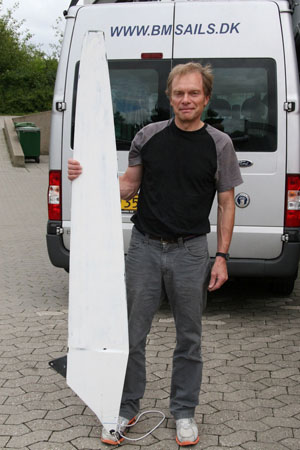 |
|
Jørgen Bojsen-Møller with the centerboard |
One of the things we spent a lot of time before the World Cup, was to fit-out the new boat when we bought a bare hull. However, we realized one month before the World Cup that if we were to make the boat ready, there would hardly be time to pratice. We therefore chose to proceed in the old boat, still super, and it was a good decision.
Another very time consuming project was the design and construction of a new centerboard. Fortunately we were able to exploit the firm KMT Northern Composite Sailing Solutions' extensive expertise in carbon fiber structures, within keel, rudder and wing design.
They scanned our design to a 3D computer model so that the company's CNC milling machine could create a plug, and also made of materials, oversized laminate and participated in the most difficult processes. The centerboard has a very high Aspect Ratio and a "good natured" profile that can deliver a relatively high lift without stalling. It also has a 10% less surface area than our previous centerboards. Despite the smaller surface it has good "hold" in the water.
We got it finished very shortly before the World Cup and has not yet learned how to use it completely. Eg. it is – as almost all 505 centerboards – a turn worth and it automatically rotates the three degrees to windward. However, reversing the effect seemed almost too good, because when we stood up in the boat to gybe the spinnaker in fresh breeze, it turned on self-selected times between the left/right side positions. The boat's surprising and sudden six-degree change of direction at high speed was close to getting us to fall out.
Evolution of 505 CB's is gone in the direction of smaller area and higher Aspect Ratio (narrow and deep). Our new centerboad is a continuation of this trend.
Membrane Sails
The Worlds was also a success for Bojsen-Møller Sails' new
membrane sails which was first across the line in 3 of 9 races and
also made several other top positions. (Hunger/Kleiner used however
BM Sails' conventional models).
What is special about membrane sails is that the fabric is made
individually for each panels in the sails. It means that you can get
the load-bearing threads in one lane to hit the corresponding wires
in neighboring lanes so that you actually have coherent threads from
corner to corner of the sail. In addition, the constructor orient
the threads in the load direction and also vary depending on line
density where large loads are in the area of the sail. The pieces
are welded together instead of being sewn. The method provides a
high stability/weight ratio.
The membrane concept is here used
in a 505 sail. You see the load-bearing threads running "unbroken"
through sail and is oriented in the load direction.
The sail is a prototype. The finished model has several (but
thinner) load-bearing threads.
Super coach
Normally we have no coach at the regattas, but since the World Cup
was now in Denmark, the former 49er sailer Peter Hansen was hired as
the Danish coach, and all boats had great benefit from Peter's
expertise. For our part, it was mainly some inputs on the mainsail
twist and the spinnaker sailing, which was very valuable.
Many thanks to Kaløvig Bådelaug and to regatta sponsor SAP for a truly great event!
2018:
Bojsen-Møller Sails fik ekstra travlt efter VM-guld i FD og 505
Jacob Bojsen-Møller keder sig ikke på sejlloftet i Humlebæk. Med sin
bror vandt han VM i FD i år, mens tysk hold med BM Sails vandt VM i
505. Interview.
2018:
Bojsen-Møller brødre rydder bordet med tre førstepladser ved 505-NM
Hellerup Sejlklub satte sig på guld og sølv ved NM i Marstrand.
Jørgen og Bojsen-Møller tog sejr foran Jan Saugman og Jacob Ernst.
Bojsen-Møller giver rapport. Svenskerne har tilgang i 505-klassen.
2019:
Den lille 505-klasse har skaffet stort EM til Sønderborg
Ti aktive 505-besætninger findes herhjemme. Alligevel kommer op
mod 100 både fra hele Europa samt Australien og USA til Danmark, når
europamesterskabet til august sejles i Sønderjylland.
